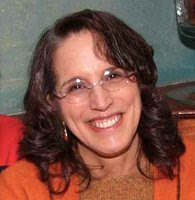 Dr. Daniel Rubey is the Dean of Library and Information Services at Hofstra University with his office in the Axinn Library [Note: Dr. Rubey played an important role in the redesigning and renovations of the Axinn Library.] He spoke to Carol Simon's class at Queens College on July 9, 2007 on the topic, Some questions currently facing academic libraries and librarians.
Dr. Daniel Rubey is the Dean of Library and Information Services at Hofstra University with his office in the Axinn Library [Note: Dr. Rubey played an important role in the redesigning and renovations of the Axinn Library.] He spoke to Carol Simon's class at Queens College on July 9, 2007 on the topic, Some questions currently facing academic libraries and librarians.He grouped the questions according to the departments in the library. As he was speaking to future librarians, he told us about the personnel in each department. Acquisitions and Collection Development has one librarian plus some staff in technical services. Technical Services, including cataloging and serials, has three librarians plus 7 or 8 staff. Reference Services includes thirteen librarians, who are subject specialists with a second MA in the subject. They do collection development, teach, and talk to people in the related departments. Systems is headed by a Dean with two assistants. Preservation is headed by an Assistant Dean with two curators and two other staff.
Acquisitions and Collections
This department has the most grants. They also deal with copyright and e-reserve issues. Hofstra uses a methodology software for student remote access to e-reserves. A major question that is facing this area is books vs. e-books. Hofstra circulates 60,000 books a year. What about textbooks (the library makes available expensive texts for in library usage and are considering a rental program)? The e-library has multiple users, but people can access only ten pages at a time. Other questions follow similarly as journals vs. e-journals. Hofstra has 250 print titles. We have 7,000 journals online (fully 1,500,000 when the law school journals are included). Do we own or access materials? How does the answer to such questions affect our budget? What about scholarly communications? What does the world of open access offer to libraries and how much do we partake? In science and business collections, do we need to increase grey literature (not published, but referred to and difficult to locate)? What about joining a consortium for collection development and buying? Consortiums bring up issues of autonomy and limiting Hofstra's choices to reach group consensus with area libraries. (An example of an electronic buying consortium is WALDO; Connect NY is a consortium for inter-library loans.) How do we use faculty liaison groups in resolving the answers to these questions?
Technical Services: Cataloging and Serials
Do we use original cataloging or do we copy cataloging? Should we outsource the cataloging? What is the purpose of the OPAC? What do we catalog? Do we include electronic sources or list them separately? Contained within this question is the issue of who can use electronic sources: only students and faculty or can others also access these for a fee? What sort of access should be provided beyond the catalog? What cataloging standards do we need to include: AACR2, Dublin Core (hypertext markup language and additional audio and video data), and/or other metadata? Do we need to catalog the departmental libraries? What about grey literature? What about Google? Do we participate in Google's digitization project? While it can make some money for the university, there are other issues that need to be resolved.
Reference Services
Do we need a reference desk or virtual reference desks? What instruction and teaching should we be responsible for? Do we need to provide a basic level of information literacy for our students and community? How has Google and Google Scholar changed reference work? Should we define levels of instruction such as basic, upper-level, and graduate? Should we be delivering distance learning? What outcomes do we want to foster and how do we assess our achievement? What faculty liaison activities should we support and encourage? What is our role in faculty research? Should we provide tutorials, guides and FAQs?
Systems
What computer architecture is best for our library? ILS systems? web pages? portals? Internet? Internet2?
What technology platform and components do we need? What computer equipment do we need? Do we provide electronic classrooms? What about sharing information? Should we have wireless access? What educational technology and/or software should we be providing? What is the best architecture for learning?
Preservation
Are we looking to preserve or replace paper? What role can JSTOR play in preservation of leading journals? Do we need compact shelving for housing paper? Hofstra has 35,000 books in off-site storage. We have 850,000 titles on microfiche. Should we turn to commercial off-site storage? Do we preserve film or turn to DVDs? Do we know (with confidence) the life expectancy (archival period) of a DVD? What are the processes and forms we should use in preserving digital information? What about faculty products that may need preservation? Other categories of content that we may need to preserve include institutional information, individual institutional repositories, shared institutional depositories, and special collections. Who are we preserving these for?

No comments:
Post a Comment